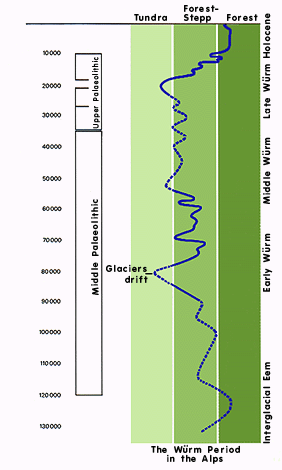 |
 The geological evolution of the earth began at least 4,5 billion years ago and was marked by endogenous (eg. orogenesis, volcano eruptions, earthquakes) and exogenous (decay, erosion) phenomena which determined its morphology. The history of the earth is divided into periods defined on the basis of the changes that took place. Nevertheless, the evolution of animals and consequently of the human species covers only 600 million years in the long history of the earth. The Quaternary (2 million years BP) is the geological period that marks the evolution of the human species. It is divided into two periods, the Pleistocene and the Holocene. The Pleistocene is also called Diluvium or Ice age (2,000.000-12,000 BP). Throughout this period there were alternating periods of cold and warm climate. In the early 20th century, geologists distinguished four glacial eras which they named in a time consequence after four big rivers in the northeastern Alps: Guenz, Mindel, Riss and Wuerm. This division stands for central and south Europe. The glaciers are characterized by cold stages with a high accumulation of ice and intermediary stages when the climate is relatively mild or even warm. The intermediary stages are referred to as Guenz/Wuermel, Mindel/Riss and Riss/Wuerm. The Pleistocene corresponds in the time scale with the Palaeolithic Period, that is the first and the longest period of the Stone Age.
|
 |
 |
 |
 |
 |
 |